Are you eager to discover the secrets of crystal hunting and unearth your own sparkling treasures? At rockscapes.net, we’ll guide you through the essential techniques on How To Find Rock Crystals, unveiling time-tested strategies for locating these geological wonders, with a focus on identifying the signs of crystal-bearing rocks, understanding geological formations, and honing your prospecting skills. Let’s explore the rewarding world of crystal prospecting, turning you into a successful rockhound!
1. What Are The Essential Techniques For Finding Rock Crystals?
The best techniques for finding rock crystals involve searching through tailings piles, finding and following float, and digging in the source pegmatite. These methods, refined over years of prospecting, enhance your chances of discovering hidden crystal treasures.
1.1. How Do You Effectively Search Tailing Piles For Rock Crystals?
Effectively searching tailing piles for rock crystals involves carefully examining discarded material from previous digs, looking for overlooked crystals or signs of potential finds. This approach can uncover treasures that others have missed.
When prospecting, always inspect both old and new digs. There are several reasons for this: to understand what the previous prospector was targeting, to potentially continue where they left off, and to search through their tailings for overlooked crystals.
- Learn from Others: By studying the rocks left behind, you can gain insights into what signs the previous prospector was following.
- Continue the Hunt: The previous prospector may have stopped digging prematurely, leaving potential crystal pockets untouched.
- Weather Reveals Hidden Treasures: Rain and snow can expose crystals that were previously hidden or coated in mud.
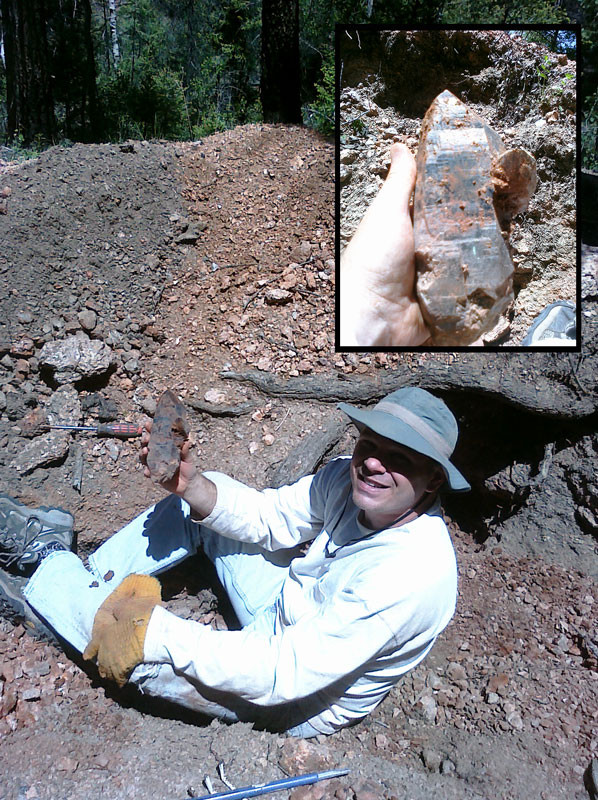 Mount Antero double terminated Phenakite my son found laying on the surface, would have been great to have more of that aquamarine attached!
Mount Antero double terminated Phenakite my son found laying on the surface, would have been great to have more of that aquamarine attached!
Tips for Searching Tailing Piles:
- Sunlight Reflection: Move around the pile to catch the sunlight reflecting off flat crystal surfaces.
- Ground Perspective: Get closer to the ground to spot crystals missed from a standing position.
- Color Identification: Look for rusty coatings indicating iron-based minerals.
- Hole Examination: Check the sides of the hole for remnants of the crystal pocket.
- Float Search: Look for signs of float (weathered crystals) originating from the pocket.
- Dig Through Tailings: Dig to uncover partially buried crystals.
It’s common for prospectors to discard crystals due to mud or iron coatings, which obscure their clarity. After a rain or snow season, Mother Nature might reveal these hidden gems. This is the simplest prospecting method, as you’re essentially benefiting from someone else’s efforts.
Some prospectors overlook “boring” or imperfect crystals, but one person’s trash is another’s treasure. Many great crystals have been found by searching the tailings of previous digs.
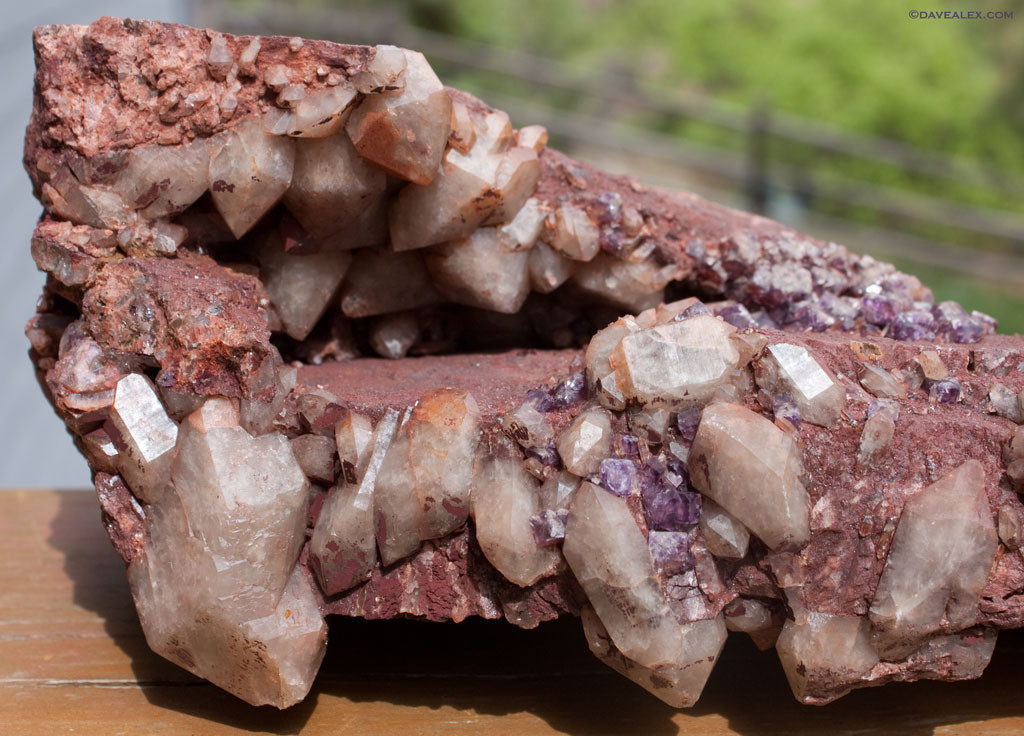 Milky Quartz and Fluorite, crystals i find in the dumps
Milky Quartz and Fluorite, crystals i find in the dumps
Learning from Others’ Digs:
Studying others’ digs provides valuable learning opportunities. What did the rocks they were pulling out look like? Are there other digs along the hillside in the same “zone” that should be checked out? What kept them digging? Larger holes often indicate successful finds.
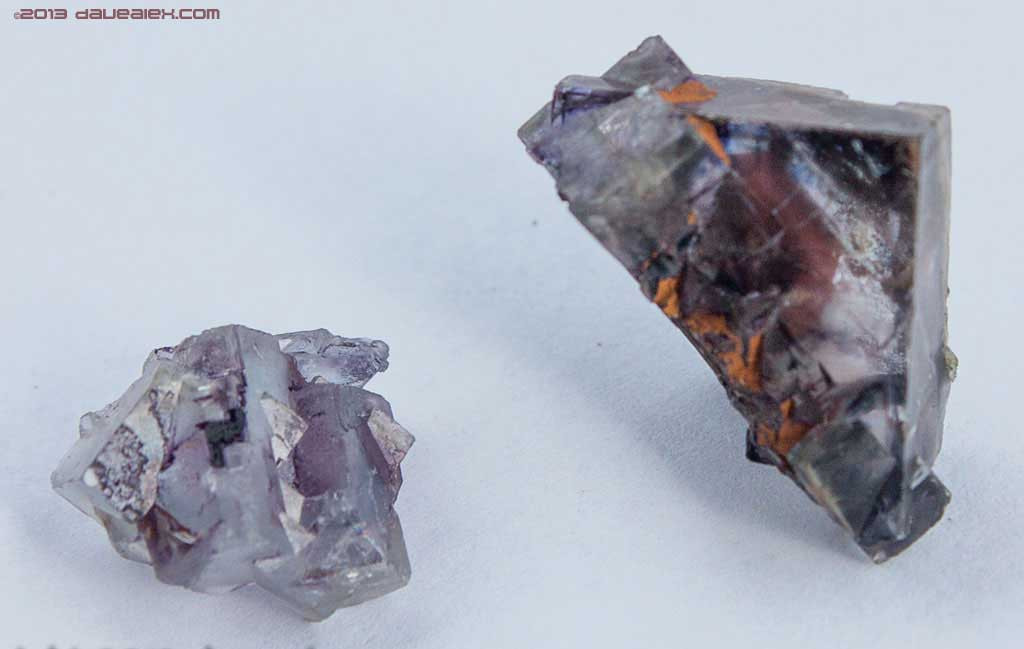 Fluorite Crystals I find looking through tailings
Fluorite Crystals I find looking through tailings
Examining Dirt Balls:
Fluorite and other crystals are heavier than regular rocks, so pay attention to the weight of rocks you extract. Always examine “dirt balls,” as they may contain crystals covered in pocket mud and dirt. These finds may require cleaning but can be rewarding.
1.2. How Can You Find And Follow Float To Locate Rock Crystals?
Finding and following float involves tracing weathered crystals back to their original source by identifying signs of erosion and geological displacement. This method can lead to significant crystal discoveries.
Float refers to rocks or crystals that have weathered out of their original location. Mother Nature has moved them over time through various processes such as glaciers, wind, and rain.
Understanding Crystal Movement:
- Glacial Movement: Crystals moved by glaciers often have broken edges, cleaved surfaces, or rounded corners due to the tumbling effect. These crystals may have traveled long distances, making it challenging to trace their origin.
- Wind and Water Erosion: These forces erode the land, displacing crystals from their original pockets. On hillsides, crystals tend to move downhill as they erode out of their original pocket. On flat areas, crystals can disperse radially away from the pocket.
Misconceptions About Float:
Many believe that float crystals are easily visible on the surface. However, float is often buried. Topsoil is a relatively recent addition in geological time, and float is often found at the boundary between the topsoil and the gravel layers.
Given the extensive prospecting in popular areas, finding crystals on the surface is rare. However, plenty of float remains to be discovered beneath the surface.
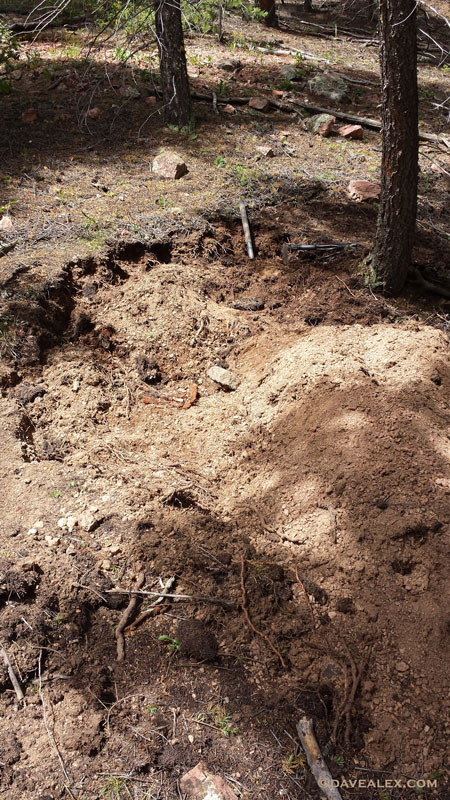 Following Float when prospecting
Following Float when prospecting
Utilizing the Float Concept:
When promising signs are found, dig test holes. Dig deep enough to reach the boundary layer between the topsoil and the gravel. On steeper hills, this layer is usually shallower. Dig a foot or two deeper to check for signs of a pegmatite outcropping.
Following Signs:
As you explore the source of the float, dig an area of several feet in diameter, moving left and right, uphill and downhill. If you continue to find signs, follow them in the direction they lead, typically uphill. The goal is to find the originating crystal pocket or seam still within the pegmatite rock.
If there are no surface signs but the area feels promising, dig test holes in likely locations. If nothing interesting is found within a 2-3 foot diameter, move on.
Dowsing Rods:
Some prospectors use dowsing rods—L-shaped rods held loosely in each hand that move when over a crystal. This technique requires experience and research.
Identifying Good Signs:
Determining what constitutes a good sign is the key to successful prospecting. Joining a crystal club or digging with experienced prospectors can be invaluable. Personal experience in moving rock and dirt is often necessary for the knowledge to truly “click.”
Key Signs to Look For:
- Flat Sides: Any rock with flat sides indicates space for crystallization.
- Quartz: Chunks of quartz, alone or mixed with microcline/feldspar, are good indicators.
- Microcline: Microcline or amazonite is another positive sign.
- Graphic Granite: This is granite where the crystal sizes increase together, suggesting proximity to a pocket.
- Combinations of the Above: Finding a mix of these elements suggests a pegmatite seam nearby.
- Crystals: Finding whole crystals or crystal faces indicates you’re close to the source.
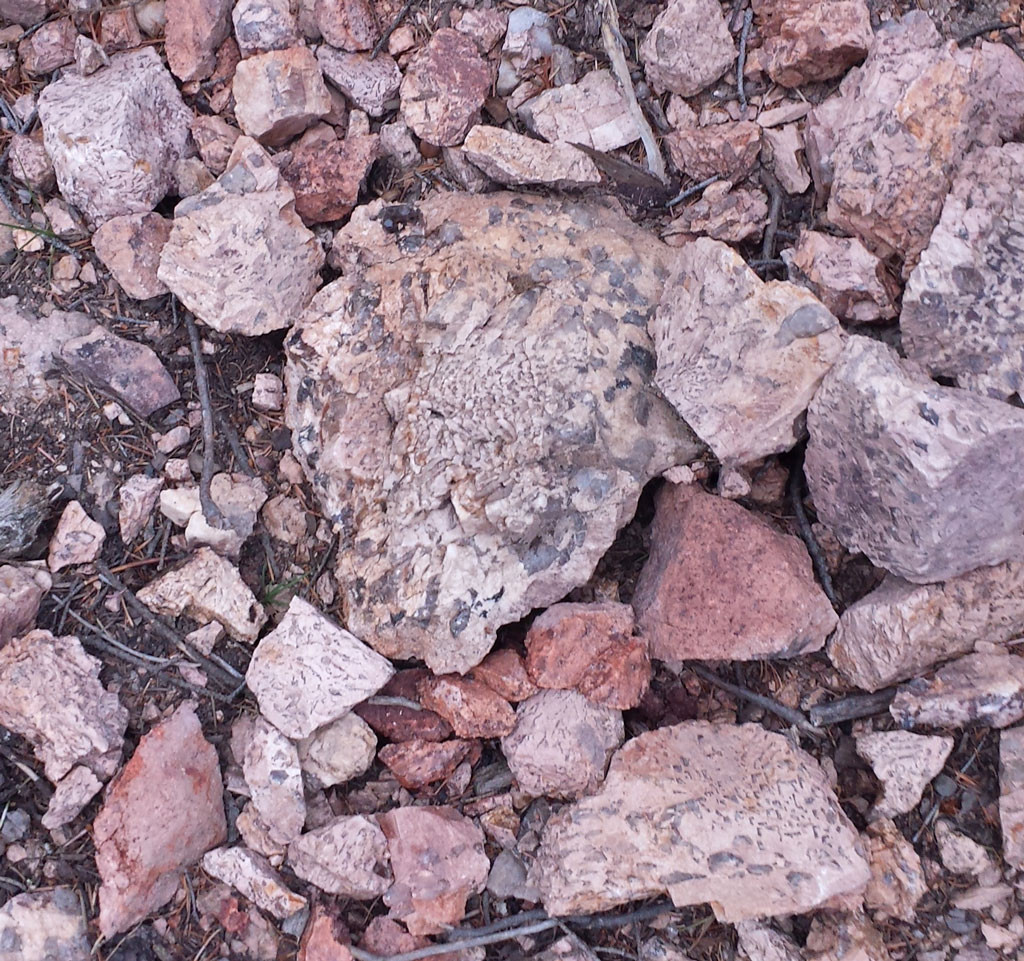 Example of graphic granite
Example of graphic granite
Additional Techniques:
When pulling out quartz or microcline chunks, leave them on top of the tailings pile near where they were found. This allows you to step back and analyze the findings from a distance, aiding in identifying patterns and clues.
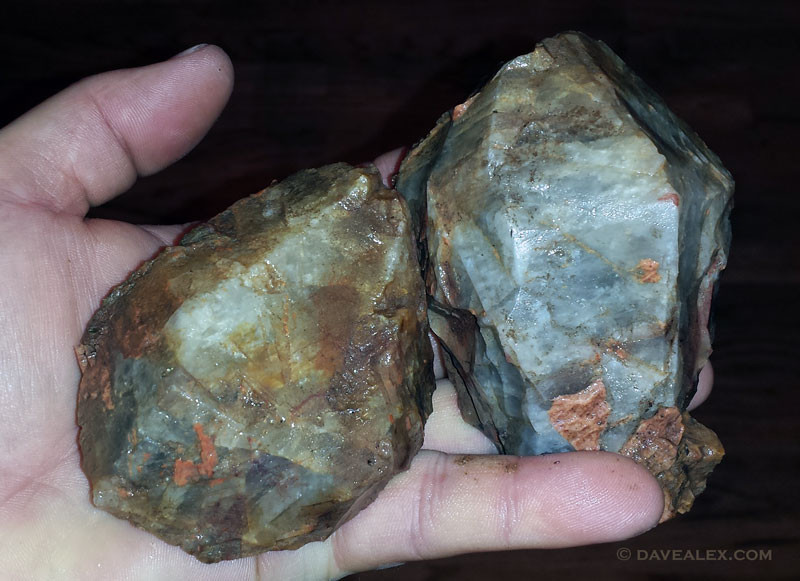 Good signs when prospecting
Good signs when prospecting
Exploring Around Existing Digs:
Another technique is to start at someone else’s dig and explore around or downhill from it. The original prospector may have been focused on the pocket material and overlooked the float.
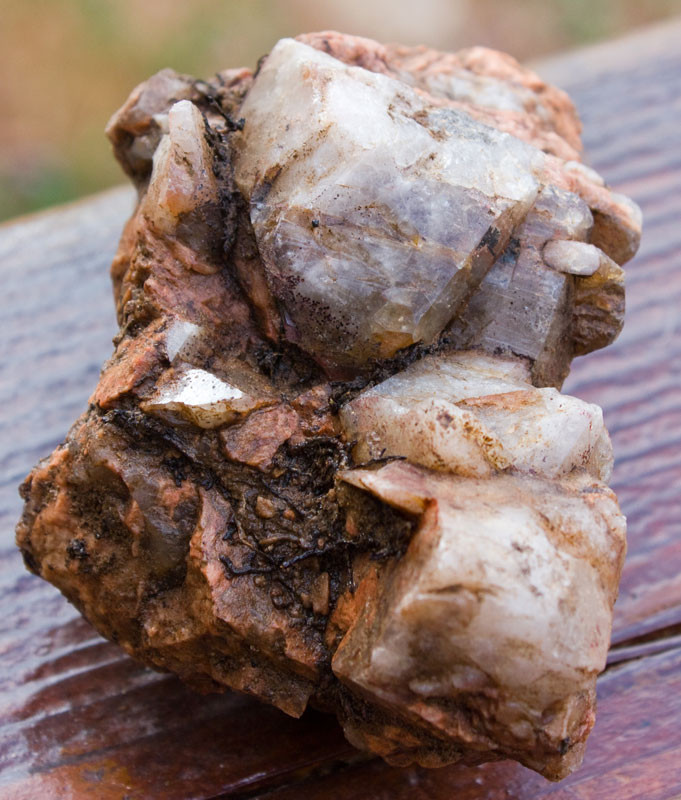 Good signs when prospecting
Good signs when prospecting
1.3. How Can You Effectively Dig In Source Pegmatites For Rock Crystals?
Effectively digging in source pegmatites for rock crystals involves identifying and excavating crystal pockets within these formations, requiring knowledge of pegmatite structures and careful excavation techniques. This is often the most rewarding approach.
Digging in crystal pockets within pegmatites is where the best quality and most plentiful crystals are typically found. However, experienced prospectors can attest to the fact that seemingly promising pockets can sometimes yield disappointing results.
Understanding Pegmatites:
Pegmatites can be viewed as lava flows of harder rock with high concentrations of sought-after minerals. Because they are flows, they tend to be long and somewhat straight, extending across or into hillsides. This knowledge helps in following the pegmatite’s path.
When conditions were right millions of years ago, mineralized fluid flowed through cracks in the rocks. This fluid crystallized in open spaces, forming pockets. These pegmatites can open up (forming crystal pockets) and then pinch out, repeating this pattern along faults or cracks. It’s possible to find pocket after pocket along the length of a single pegmatite.
Remember that a previous prospector might have found a great pocket but didn’t finish it or follow it as it opened into an even larger pocket along the pegmatite’s length.
Factors Influencing Pocket Formation:
- Intersection of Faults: Pockets often form at the intersection of faults. When two pegmatites intersect, a pocket may form.
- Bends in Pegmatites: Pegmatites that bend can also form pockets, possibly due to eddies during the liquid phase.
Pegmatites are often surrounded by gravel or dirt, as the surrounding rock decomposes over geologic time. This helps in identifying the boundaries of the pegmatite. Avoid spending too much time digging in areas with just gravel. If there are chunks of pegmatite, quartz, or microcline, continue digging, as you may be digging into a pegmatite. If you were in pegmatite and then enter gravel, change direction, as you likely found the border of the pegmatite.
Ensure larger chunks of rock are pegmatite and not just solid granite, as crystals are unlikely to be found outside of pegmatite. Sometimes, all the surrounding rock is gone, leaving a trail of crystals in gravel or dirt.
Categorizing Pegmatites:
Pegmatites can be categorized as chunks or solid masses. Solid masses require the most digging effort. Sometimes, a pegmatite is still intact as massive rock with a seam sandwiched between granite plates. Small crystal pockets can be found in these seams, especially where they widen.
Following these openings can lead to deeper pockets. These pegmatite chunks can be large and heavy, requiring pry bars and chisels. Always use safe leverage and lifting techniques and wear eye protection. Follow the pegmatite in all directions, as the crack or seam may be long and wide but eventually could widen and form a pocket.
2. What Geological Formations Are Most Likely To Contain Rock Crystals?
Geological formations most likely to contain rock crystals include pegmatites, vugs, and hydrothermal veins, all of which provide the necessary conditions for crystal growth. Understanding these formations is essential for successful crystal hunting.
2.1. Why Are Pegmatites Ideal For Finding Rock Crystals?
Pegmatites are ideal for finding rock crystals due to their slow cooling process and high concentration of volatile elements, which allow for the formation of large, well-formed crystals. These geological features are prime locations for prospectors.
Pegmatites are intrusive igneous rocks known for their exceptionally large crystals. They form during the final stages of magma crystallization, when residual fluids rich in water, fluorine, boron, and other volatile elements are present. These fluids lower the viscosity of the magma, allowing ions to move more freely and form large crystals.
According to research from Arizona State University’s School of Earth and Space Exploration, pegmatites often contain valuable minerals such as quartz, feldspar, mica, and tourmaline, which can occur as large, well-formed crystals.
Conditions for Crystal Growth:
The key to pegmatite crystal formation is the right combination of elements and conditions.
- High Concentration of Volatile Elements: The presence of water, fluorine, and boron helps to lower the viscosity of the magma, facilitating the growth of large crystals.
- Slow Cooling Process: This allows more time for crystals to grow without interference.
- Open Spaces: Cracks and cavities within the pegmatite provide space for the crystals to grow freely.
Pegmatite Composition:
Pegmatites typically consist of quartz, feldspar, and mica, but can also contain a variety of other minerals such as tourmaline, beryl, spodumene, and topaz. The specific mineral composition depends on the source magma and the regional geology.
Pegmatite Locations:
Pegmatites are found in many regions around the world, often in association with large granite intrusions. Some notable locations include:
- Colorado, USA: Known for its pegmatites containing amazonite, smoky quartz, and topaz.
- Brazil: Rich in pegmatites with tourmaline, beryl, and spodumene.
- Madagascar: Famous for its pegmatites containing a variety of rare minerals, including tourmaline and beryl.
Prospecting Pegmatites:
When prospecting for crystals in pegmatites, it is important to look for signs of mineralization, such as:
- Quartz Veins: These can indicate the presence of pegmatite.
- Feldspar Outcrops: Large feldspar crystals are a common component of pegmatites.
- Mica Flakes: These shiny flakes can indicate the presence of mica-rich pegmatite.
- Surface Crystals: Weathered crystals on the surface can indicate the presence of a pocket below.
2.2. How Do Vugs Contribute To Rock Crystal Formation?
Vugs contribute to rock crystal formation by providing open spaces within rocks where crystals can grow freely, undisturbed by surrounding pressure. These cavities create ideal conditions for crystal development.
Vugs are small to large cavities or openings within a rock that provide an ideal environment for crystal growth. They form through various processes, such as the dissolution of minerals by acidic groundwater or the incomplete filling of gas bubbles during volcanic activity.
According to research from the University of Arizona’s Department of Geosciences, vugs are commonly found in sedimentary rocks like geodes and in volcanic rocks such as basalts.
Formation of Vugs:
- Dissolution: Acidic groundwater can dissolve certain minerals in the rock, creating a cavity.
- Gas Bubbles: During volcanic eruptions, gas bubbles can become trapped in the cooling lava, forming vugs.
- Fracturing: Fractures in the rock can create open spaces that later become vugs.
Ideal Conditions for Crystal Growth:
Vugs provide the necessary space and conditions for crystals to grow without interference from the surrounding rock matrix.
- Open Space: Crystals can develop their characteristic shapes without being constrained.
- Slow Precipitation: Minerals slowly precipitate from groundwater solutions onto the walls of the vug, forming crystals over time.
- Stable Environment: The enclosed nature of vugs protects crystals from external disturbances.
Common Minerals in Vugs:
Vugs can contain a variety of minerals, depending on the rock type and the chemical composition of the groundwater. Common minerals found in vugs include:
- Quartz: Clear or colored quartz crystals, such as amethyst and citrine.
- Calcite: Often forms scalenohedral or dogtooth-shaped crystals.
- Zeolites: A group of hydrated aluminosilicate minerals that form in volcanic rocks.
- Fluorite: Can form cubic or octahedral crystals in a variety of colors.
Finding Vugs:
When prospecting for vugs, it is important to understand the geology of the area. Look for rock formations known to contain vugs, such as:
- Geodes: These rounded, nodule-like rocks often contain vugs lined with quartz crystals.
- Basalts: Volcanic rocks that may contain vugs filled with zeolites or other minerals.
- Limestone: Sedimentary rocks that can contain vugs formed by the dissolution of calcite.
Prospecting Tips:
- Examine Rock Surfaces: Look for rounded or irregular shapes on the surface of rocks that may indicate the presence of a vug.
- Listen for Hollow Sounds: Tapping on rocks may reveal a hollow sound if a vug is present.
- Break Open Rocks: Carefully break open promising rocks with a hammer and chisel to reveal any hidden vugs.
2.3. How Do Hydrothermal Veins Facilitate Rock Crystal Growth?
Hydrothermal veins facilitate rock crystal growth by acting as pathways for hot, mineral-rich fluids that deposit crystals as they cool. These veins are critical for understanding where to find high-quality rock crystals.
Hydrothermal veins are fractures in rocks that have been filled with minerals precipitated from hot, aqueous solutions. These veins form when groundwater is heated by magma or geothermal activity and becomes enriched with dissolved minerals.
According to research from the U.S. Geological Survey (USGS), hydrothermal veins are a common source of many valuable minerals, including gold, silver, copper, and quartz crystals.
Formation of Hydrothermal Veins:
- Fracturing: Tectonic forces create fractures in the rock.
- Fluid Circulation: Hot, mineral-rich fluids circulate through the fractures.
- Mineral Deposition: As the fluids cool, they deposit minerals on the walls of the fractures, forming veins.
Ideal Conditions for Crystal Growth:
- Slow Cooling: Gradual cooling of the hydrothermal fluids allows for the slow and orderly growth of crystals.
- Open Space: Fractures provide open space for crystals to grow.
- High Mineral Concentration: The fluids are highly concentrated with dissolved minerals, providing the building blocks for crystal formation.
Types of Hydrothermal Veins:
- Epithermal Veins: Form at shallow depths and relatively low temperatures (less than 200°C).
- Mesothermal Veins: Form at intermediate depths and temperatures (200-300°C).
- Hypothermal Veins: Form at great depths and high temperatures (300-500°C).
Common Minerals in Hydrothermal Veins:
- Quartz: Often forms large, well-developed crystals in hydrothermal veins.
- Calcite: Can be found as vein fillings or as crystals in vugs within the veins.
- Fluorite: Forms in hydrothermal veins, often associated with quartz and calcite.
- Galena: A lead sulfide mineral commonly found in hydrothermal veins.
- Sphalerite: A zinc sulfide mineral also found in hydrothermal veins.
Finding Hydrothermal Veins:
When prospecting for hydrothermal veins, look for the following signs:
- Altered Rock: Hydrothermal alteration can change the color and texture of the surrounding rock.
- Vein Outcrops: Look for veins that are exposed on the surface.
- Fault Zones: Hydrothermal veins often follow fault lines.
Prospecting Tips:
- Examine Rock Samples: Look for veins in rock samples collected from the area.
- Use a Geological Map: Geological maps can show the location of known hydrothermal veins.
- Follow Veins: Once you find a vein, follow it to see if it widens or contains pockets of crystals.
3. What Are The Essential Prospecting Skills For Locating Rock Crystals?
Essential prospecting skills for locating rock crystals include identifying geological indicators, understanding mineral properties, and mastering excavation techniques. These skills are crucial for any successful crystal hunter.
3.1. How Do You Identify Geological Indicators Of Rock Crystals?
Identifying geological indicators of rock crystals involves recognizing rock types, formations, and surface features that suggest crystal-bearing areas. This skill is fundamental for efficient prospecting.
To find crystals, you need to understand the geological indicators that suggest their presence. This involves knowing which rock types and formations are likely to host crystals and recognizing surface features that point to potential crystal-bearing areas.
Rock Types:
- Pegmatites: As mentioned earlier, pegmatites are a prime source of crystals.
- Volcanic Rocks: Basalts and other volcanic rocks can contain vugs filled with crystals.
- Sedimentary Rocks: Geodes and other sedimentary formations can host crystals.
- Metamorphic Rocks: Certain metamorphic rocks, such as schists and gneisses, can contain crystals.
Formations:
- Veins: Hydrothermal veins are often associated with crystal formation.
- Fault Zones: Faults can create pathways for mineral-rich fluids to deposit crystals.
- Contact Zones: The boundaries between different rock types can be favorable for crystal growth.
Surface Features:
- Quartz Outcrops: Quartz veins or outcrops can indicate the presence of crystals.
- Mineral Staining: Unusual colors or stains on rocks can indicate mineralization.
- Rock Debris: Piles of rock debris may contain crystal fragments.
- Vegetation: Certain types of vegetation may grow in areas with specific mineral deposits.
Identifying Quartz:
Quartz is one of the most common minerals and is often associated with other crystals. It is important to be able to identify quartz in its various forms:
- Clear Quartz: Transparent and colorless.
- Smoky Quartz: Gray or brown due to natural irradiation.
- Amethyst: Purple due to the presence of iron impurities.
- Citrine: Yellow or orange due to iron impurities.
- Rose Quartz: Pink due to the presence of titanium or iron impurities.
According to research from the Mineralogical Society of America, quartz is characterized by its hardness, conchoidal fracture, and glassy luster.
Identifying Feldspar:
Feldspar is another common mineral found in association with crystals. It is important to be able to identify feldspar in its various forms:
- Orthoclase: A potassium-rich feldspar, often pink or white.
- Plagioclase: A sodium- or calcium-rich feldspar, often white or gray.
- Amazonite: A green variety of microcline feldspar.
Feldspar is characterized by its hardness, cleavage, and often striated surfaces.
Using Geological Maps:
Geological maps can provide valuable information about the rock types and formations in an area. These maps can help you identify potential crystal-bearing locations.
Consulting Local Experts:
Local geologists, rockhounds, and mineral collectors can provide valuable insights into the best places to find crystals in a particular area.
3.2. How Does Understanding Mineral Properties Aid In Finding Rock Crystals?
Understanding mineral properties aids in finding rock crystals by allowing prospectors to identify potential crystals based on characteristics like hardness, luster, and color. This knowledge streamlines the search process.
Understanding the properties of minerals is crucial for identifying potential crystals in the field. Each mineral has unique characteristics that can help you distinguish it from other rocks and minerals.
Hardness:
Hardness is a measure of a mineral’s resistance to scratching. The Mohs Hardness Scale is used to rank minerals from 1 (talc) to 10 (diamond).
- Quartz: Has a hardness of 7, meaning it can scratch glass.
- Feldspar: Has a hardness of 6, meaning it can scratch glass with difficulty.
- Calcite: Has a hardness of 3, meaning it can be scratched by a copper coin.
Luster:
Luster describes how light reflects off a mineral’s surface.
- Metallic: Looks like a metal, such as pyrite (fool’s gold).
- Glassy (Vitreous): Looks like glass, such as quartz.
- Dull (Earthy): Lacks a noticeable shine, such as clay minerals.
- Resinous: Looks like resin, such as sphalerite.
Color:
Color can be a helpful property for identifying minerals, but it is important to note that color can vary depending on impurities.
- Quartz: Can be clear, white, gray, purple (amethyst), yellow (citrine), pink (rose quartz), etc.
- Fluorite: Can be purple, green, yellow, blue, or colorless.
- Calcite: Can be white, yellow, pink, or brown.
Streak:
Streak is the color of a mineral’s powder when it is rubbed across a streak plate (a piece of unglazed porcelain).
- Hematite: Has a red-brown streak.
- Pyrite: Has a black streak.
- Galena: Has a gray streak.
Cleavage and Fracture:
Cleavage is the tendency of a mineral to break along specific planes of weakness. Fracture is the way a mineral breaks when it does not cleave.
- Quartz: Has conchoidal fracture, meaning it breaks with a curved, shell-like surface.
- Feldspar: Has two directions of cleavage at approximately 90 degrees.
- Calcite: Has three directions of cleavage, forming rhombic shapes.
Density:
Density is a measure of a mineral’s mass per unit volume.
- Galena: Is very dense due to its high lead content.
- Barite: Is also relatively dense due to its barium content.
Using a Hand Lens:
A hand lens can be a valuable tool for examining mineral properties in the field. It can help you see small details such as crystal shapes, cleavage planes, and surface textures.
Taking Notes:
Keep a notebook with you in the field to record your observations about the minerals you find. Note the color, luster, hardness, cleavage, and any other identifying characteristics.
3.3. What Excavation Techniques Maximize Rock Crystal Discovery?
Excavation techniques that maximize rock crystal discovery involve careful digging, proper tool use, and preserving crystal integrity. These methods ensure successful and safe crystal retrieval.
Once you have identified a promising location for crystals, it is important to use proper excavation techniques to maximize your chances of finding crystals and to preserve their integrity.
Tools:
- Shovel: For removing overburden and digging test holes.
- Pickaxe: For breaking up hard rock.
- Hammer and Chisel: For carefully removing rock around crystals.
- Screwdriver or Probe: For probing into cracks and crevices.
- Brush: For cleaning crystals.
- Gloves: To protect your hands.
- Eye Protection: To protect your eyes from flying debris.
Techniques:
- Start with a Test Hole: Dig a small test hole to see if there are any signs of crystals.
- Remove Overburden: Carefully remove the soil and rock that is covering the potential crystal-bearing area.
- Follow Veins and Seams: If you find a vein or seam, follow it to see if it leads to a pocket of crystals.
- Use a Hammer and Chisel: Carefully remove rock around crystals to avoid damaging them.
- Probe into Cracks: Use a screwdriver or probe to check for crystals in cracks and crevices.
- Clean Crystals: Use a brush to gently clean the crystals.
Preserving Crystal Integrity:
- Avoid Using Excessive Force: Use gentle, controlled movements to avoid breaking crystals.
- Support Crystals: If a crystal is loose, support it with your hand or a piece of foam.
- Protect Crystals from Scratches: Store crystals in padded containers to protect them from scratches.
Safety:
- Wear Eye Protection: Always wear eye protection when excavating to protect your eyes from flying debris.
- Wear Gloves: Wear gloves to protect your hands from sharp rocks and minerals.
- Be Aware of Your Surroundings: Be aware of potential hazards such as falling rocks, steep slopes, and wildlife.
Ethical Considerations:
- Obtain Permission: Always obtain permission from the landowner before excavating.
- Fill in Holes: Fill in any holes you dig to minimize your impact on the environment.
- Leave No Trace: Pack out all trash and leave the area as you found it.
By using proper excavation techniques and following these guidelines, you can maximize your chances of finding crystals while preserving their integrity and protecting the environment.
4. What Are The Latest Trends In Rock Crystal Prospecting In The USA?
The latest trends in rock crystal prospecting in the USA include the use of advanced technology, sustainable practices, and increased interest in rare minerals. Staying updated with these trends can enhance your prospecting success.
4.1. How Is Technology Enhancing Rock Crystal Prospecting?
Technology is enhancing rock crystal prospecting through tools like drones, GPS, and spectral analysis, which improve efficiency and accuracy in locating crystal deposits. These advancements are transforming the field of mineral exploration.
Technology is rapidly changing the landscape of rock crystal prospecting. Advanced tools and techniques are making it easier and more efficient to locate and extract crystals.
Drones:
Drones equipped with high-resolution cameras and sensors are being used to survey large areas quickly and efficiently. Drones can identify potential crystal-bearing areas by analyzing surface features, vegetation patterns, and mineral signatures.
According to a report by the Geological Society of America, drones can significantly reduce the time and cost of mineral exploration.
GPS:
Global Positioning System (GPS) technology is used to accurately map and record the location of crystal finds. GPS devices can help prospectors navigate to specific locations and track their movements in the field.
Spectral Analysis:
Spectral analysis is a technique that uses the interaction of light with minerals to identify their composition. Portable spectral analyzers can be used in the field to quickly identify potential crystal specimens.
Geophysical Surveys:
Geophysical surveys, such as ground-penetrating radar (GPR) and electromagnetic (EM) surveys, can be used to image subsurface features and identify potential crystal deposits.
GIS:
Geographic Information Systems (GIS) are used to integrate and analyze various types of geological data, such as geological maps, satellite imagery, and geophysical surveys. GIS can help prospectors identify potential crystal-bearing areas based on multiple lines of evidence.
Online Resources:
Online databases and forums provide a wealth of information about crystal locations, mineral identification, and prospecting techniques. These resources can help prospectors stay up-to-date on the latest discoveries and trends.
4.2. What Sustainable Practices Are Being Adopted In Rock Crystal Prospecting?
Sustainable practices in rock crystal prospecting involve minimizing environmental impact through responsible excavation, land restoration, and ethical sourcing. These practices are essential for preserving natural resources.
As interest in rock crystal prospecting grows, there is an increasing emphasis on sustainable practices. Prospectors are adopting techniques that minimize environmental impact and ensure the long-term viability of crystal resources.
Responsible Excavation:
- Minimize Disturbance: Use hand tools and small-scale equipment to minimize disturbance to the surrounding environment.
- Avoid Damage to Vegetation: Take care to avoid damaging vegetation when excavating.
- Fill in Holes: Fill in any holes you dig to prevent erosion and protect wildlife.
- Avoid Contamination: Prevent contamination of soil and water by avoiding the use of chemicals or heavy equipment.
Land Restoration:
- Revegetation: Plant native vegetation to restore disturbed areas.
- Soil Stabilization: Use erosion control measures to stabilize soil and prevent erosion.
- Water Management: Implement water management practices to protect water quality.
Ethical Sourcing:
- Obtain Permission: Always obtain permission from the landowner before excavating.
- Respect Local Communities: Respect the rights and traditions of local communities.
- Support Fair Trade: Support fair trade practices that ensure that crystal miners are paid a fair wage.
Education and Awareness:
- Promote Sustainable Practices: Educate other prospectors about sustainable practices.
- Raise Awareness: Raise awareness about the importance of protecting crystal resources.
4.3. What Rare Minerals Are Currently Highly Sought After By Prospectors In The USA?
Rare minerals currently highly sought after by prospectors in the USA include benitoite, painite, and red beryl, due to their rarity, beauty, and value. These minerals attract significant attention from collectors and enthusiasts.
Certain rare minerals are highly sought after by prospectors due to their beauty, rarity, and value.
Benitoite:
Benitoite is a rare blue barium titanium silicate mineral found primarily in California. It is the official state gem of California and is highly prized by collectors.
Painite:
Painite is an extremely rare borate mineral that was first discovered in Myanmar. It is one of the rarest minerals on Earth and is highly sought after by collectors.
Red Beryl:
Red beryl, also known as bixbite, is a rare variety of beryl that is found in Utah and New Mexico. It is one of the rarest and most valuable varieties of beryl.
Euclase:
Euclase is a rare beryllium aluminum silicate mineral that is found in pegmatites and hydrothermal veins. It is prized for its beautiful blue or green color.
Jeremejevite:
Jeremejevite is a rare aluminum borate fluoride mineral that is found in Namibia and Tajikistan. It is known for its beautiful blue or colorless crystals.
Grandidierite:
Grandiderite is a rare magnesium aluminum borosilicate mineral that is found in Madagascar and Sri Lanka. It is known for its beautiful blue-green color.
Musgravite:
Musgravite is a rare magnesium aluminum oxide mineral that is found in Antarctica, Greenland, and Sri Lanka. It is one of the rarest gemstones in the world.
Key Takeaways:
| Trend | Description | Benefits |
|---|---|---|
| Technology | Use of drones, GPS, spectral analysis, geophysical surveys, and GIS to locate and extract crystals. | Increased efficiency, reduced costs, improved accuracy, and better identification of crystal deposits. |
| Sustainable Practices | Responsible excavation, land restoration, ethical sourcing, education, and awareness. | Minimized environmental impact, long-term viability of crystal resources, respect for local communities, and fair treatment of crystal miners. |
| Rare Minerals | Focus on benitoite, painite, red beryl, euclase, jeremejevite, grandidierite, and musgravite due to their beauty, rarity, and value. | High potential for financial reward, opportunity to discover unique and valuable specimens, and contribution to scientific knowledge. |
5. What Are Some Frequently Asked Questions About Finding Rock Crystals?
Here are some frequently asked questions about finding rock crystals, designed to provide quick and informative answers for both novice and experienced prospectors.
5.1. What Is The Best Time Of Year To Search For Rock Crystals?
The best time of year to search for rock crystals is typically during the spring and fall, when the weather is mild and vegetation is less dense, making it easier to spot geological indicators.
5.2. What Tools Are Essential For Rock Crystal Prospecting?
Essential tools for rock crystal prospecting include a shovel, pickaxe, hammer, chisel, hand lens, and a guidebook for
